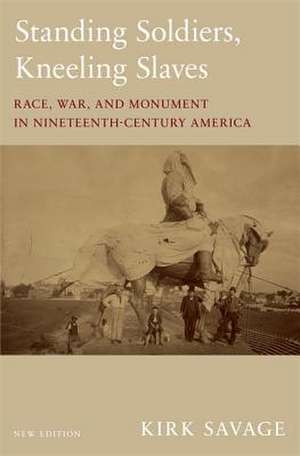Standing Soldiers, Kneeling Slaves – Race, War, and Monument in Nineteenth–Century America, New Edition
Autor Kirk Savageen Limba Engleză Paperback – 2 iul 2018
The United States began as a slave society, holding millions of Africans and their descendants in bondage, and remained so until a civil war took the lives of a half million soldiers, some once slaves themselves. Standing Soldiers, Kneeling Slaves explores how the history of slavery and its violent end was told in public spaces--specifically in the sculptural monuments that came to dominate streets, parks, and town squares in nineteenth-century America. Looking at monuments built and unbuilt, Kirk Savage shows how the greatest era of monument building in American history took place amid struggles over race, gender, and collective memory. Standing Soldiers, Kneeling Slaves probes a host of fascinating questions and remains the only sustained investigation of post-Civil War monument building as a process of national and racial definition. Featuring a new preface by the author that reflects on recent events surrounding the meaning of these monuments, and new photography and illustrations throughout, this new and expanded edition reveals how monuments exposed the myth of a "united" people, and have only become more controversial with the passage of time.
Preț: 187.14 lei
Nou
Puncte Express: 281
Preț estimativ în valută:
35.81€ • 37.49$ • 29.63£
35.81€ • 37.49$ • 29.63£
Carte disponibilă
Livrare economică 15-29 martie
Preluare comenzi: 021 569.72.76
Specificații
ISBN-13: 9780691183152
ISBN-10: 0691183155
Pagini: 296
Dimensiuni: 171 x 240 x 22 mm
Greutate: 0.52 kg
Editura: Princeton University Press
ISBN-10: 0691183155
Pagini: 296
Dimensiuni: 171 x 240 x 22 mm
Greutate: 0.52 kg
Editura: Princeton University Press
Notă biografică
Kirk Savage is the William S. Dietrich II Professor of History of Art and Architecture at the University of Pittsburgh. He is the author of Monument Wars: Washington D.C., the National Mall, and the Transformation of the Memorial Landscape (Princeton) and the editor of The Civil War in Art and Memory.
